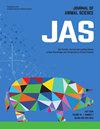52一种益生菌微生物凝胶与两种直接饲喂微生物添加剂联合饲喂牛日粮对生长性能和健康的影响
IF 2.7
2区 农林科学
Q1 AGRICULTURE, DAIRY & ANIMAL SCIENCE
引用次数: 0
摘要
目的是评估抵达后施用的益生菌微生物凝胶(BIOFRESH®微生物凝胶,Agrarian Solutions)与饲喂两种不同的直接饲喂微生物(DFM 365a或DFM 365b, Agrarian Solutions)中的一种对牛呼吸道疾病(BRD)高风险牲畜犊牛的健康和生长性能的影响。在为期42天的研究中,研究人员使用了在3个不同接收日期到达的肉牛犊牛(n = 292,体重= 216±1 kg)。抵达后(d -1),对雏牛进行加工,按d -1体重分层,随机分配到9个栏中(10 ~ 12头/栏);共27支笔)。在卡车装载中,随机分配给饲粮处理(9只/处理)。犊牛饲养在0.45公顷的草地围场上,饲喂谷物添加剂,作为直接饲喂微生物日粮处理的载体。试验分别为:1)CON(不直接饲喂微生物的谷物补料)、2)DFMaGEL(第0天益生菌凝胶剂量,随后饲喂含DFM 365a的谷物补料,每天采食量目标1.25g/头母牛)和3)DFMbGEL(第0天益生菌凝胶剂量,随后饲喂含DFM 365b的谷物补料,每天采食量目标2.50g/头母牛)。在第14、28、41和42天分别记录初始(第1 d和第0 d)和饲喂前的体重。每天对牛的发病率进行观察,对出现BRD症状且直肠温度≥40°C的牛使用预先确定的标准方案进行抗生素治疗。采用SAS 9.4的mix和GLIMMIX程序进行统计分析,卡车载荷为随机效应,卡车载荷内的笔指定为受试者。与使用con的犊牛相比,在犊牛出生后的前42天,分别添加DFMaGel和DFMbGEL处理的犊牛在体重(P≥0.65)和平均日增重(P≥0.46)方面没有差异。CON = 0.88, DFMaGEL = 0.84, DFMbGEL = 0.92 kg/d)。治疗对该接受期的发病率无影响(P≥0.12;CON= 48%, DFMaGEL= 44%, DFMbGEL= 55%)。抗生素相关费用(P = 0.36;CON = 14.03美元,DFMaGEL = 14.31美元,DFMbGEL = 18.43美元)治疗间无差异。综上所述,在42天的接受期内,在加工过程中使用益生菌凝胶与直接饲喂的微生物补充剂相结合,对高风险肉牛犊牛的整体健康或生长性能没有影响。本文章由计算机程序翻译,如有差异,请以英文原文为准。
52 Effect of a probiotic microbial gel jointly with two versions of supplemental direct-fed microbials in receiving cattle diets on growth performance and health
The objective was to assess the effect of a probiotic microbial gel (BIOFRESH® Microbial Gel, Agrarian Solutions) administered on arrival in combination with feeding one of two different direct-fed microbials (DFM 365a or DFM 365b, Agrarian Solutions) on the health and growth performance of stocker calves at high risk for bovine respiratory disease (BRD). Beef heifer calves (n = 292, BW = 216 ± 1 kg) arriving on 3 separate receiving dates were used in the 42-day receiving study. On arrival (d -1), heifers were processed, stratified by d -1 body weight, and then assigned randomly to 9 pens (10 to 12 heifers/pen; total of 27 pens). Within truckloads, pens were assigned randomly to dietary treatment (9 pens/treatment). Calves were housed on 0.45 ha grass paddocks and fed grain supplements that served as carriers of the direct-fed microbial dietary treatments. The treatments were: 1) CON (grain supplement with no direct fed microbial), 2) DFMaGEL (dose of probiotic gel on d 0 then subsequent feeding of grain supplement with DFM 365a, intake goal 1.25g/heifer each day), and 3) DFMbGEL (dose of probiotic gel on d 0 then subsequent feeding of grain supplement with DFM 365b, intake goal 2.50g/heifer each day). Weights were recorded initially (d -1 and 0) and before feeding on days 14, 28, 41, and 42. Cattle were observed daily for morbidity, and cattle that presented symptoms of BRD and had rectal temperature ≥ 40°C were treated with antibiotics using a standard predetermined protocol. Statistical analyses were performed using MIXED and GLIMMIX procedures of SAS 9.4 with truckload as a random effect and pen within truckload specified as the subject. Supplementing cattle for the first 42 days after arrival with DFMaGel and DFMbGEL treatments did not result in differences in body weights (P ≥ 0.65) or average daily gain (P ≥ 0.46) when compared to calves receiving the CON. There was a numerical advantage in overall gain for the calves receiving the DFMbGEL treatment (P = 0.46; CON = 0.88, DFMaGEL = 0.84, DFMbGEL = 0.92 kg/d). Treatments did not affect morbidity incidences within this receiving period (P ≥ 0.12; CON= 48%, DFMaGEL= 44%, DFMbGEL= 55%). The antibiotic-associated costs (P = 0.36; CON = $14.03, DFMaGEL = $14.31, DFMbGEL = $18.43) did not differ between treatments. In conclusion, administering a probiotic gel at processing in combination with either direct-fed microbial supplement did not affect the overall health or growth performance during this 42-d receiving period in high-risk beef heifer calves.
求助全文
通过发布文献求助,成功后即可免费获取论文全文。
去求助
来源期刊

Journal of animal science
农林科学-奶制品与动物科学
CiteScore
4.80
自引率
12.10%
发文量
1589
审稿时长
3 months
期刊介绍:
The Journal of Animal Science (JAS) is the premier journal for animal science and serves as the leading source of new knowledge and perspective in this area. JAS publishes more than 500 fully reviewed research articles, invited reviews, technical notes, and letters to the editor each year.
Articles published in JAS encompass a broad range of research topics in animal production and fundamental aspects of genetics, nutrition, physiology, and preparation and utilization of animal products. Articles typically report research with beef cattle, companion animals, goats, horses, pigs, and sheep; however, studies involving other farm animals, aquatic and wildlife species, and laboratory animal species that address fundamental questions related to livestock and companion animal biology will be considered for publication.
 求助内容:
求助内容: 应助结果提醒方式:
应助结果提醒方式:


